A BRIEF ON CRAZYHORSE (CONTINUED)
By Bandit |
| My real killer paint job did not show up. The customer only showed the bike in Louisville. But it is the wildest paint job I have ever done. I have attached 3 pics of it.


 -Crazyhorse |
Back to Page 1….
| |
Dayroll Comes Alive
By Bandit |
Bandit’s Dayroll is available for purchase in Bandit’s Gift Shop
|
|
On a toasty Sunday afternoon, I was called from my tiny digs in the sizzling valley to the salt air breezes on the coast by a petite blonde with a hankerin’ for sun-settin’ delights before and after dinner. I couldn’t resist and with only a T-shirt and a vest on, I hit the road over Malibu Canyon to the Pacific Coast. As I passed traffic, the sun began to duck behind one jagged mountain crest after another and the shadows brought on a warning chill. I knew what lay ahead, the refreshing onshore breeze, the chilly evening mist, and the downright cold evening dew. That’s when I started thinking about the lean FXR I was riding at the time. |
| It didn’t want to mar the scalloped side panels with saddlebags, strap a tool bag to the motormount, wind bungee cords around my handlebars, or make a dresser out of the high-bar FXR. I thought about the Old West and the bedrolls the cowboys used to carry their shit, and it came to me. Something over the headlight, as long as it wasn’t too heavy, could do the trick. The bike would maintain its nasty profile, I could still pack someone on the back, and carry my shit.
As I wound through the canyon, my mind went to work on the bedroll concept. Could it carry all I wanted to pack? I thought about the last time I took a weekend run. I had grabbed a promotional cordura bag, packed some clothes and a ditty bag in it and strapped it to my front end. That was it, a hollow, durable cordura bag with pockets on the ends for keys, maps, padlocks, chapstick, nuts and bolts, and rubbers, perhaps not in that order. Another question smacked me as I rounded another corner and caught a glimpse of the Pacific lapping the Malibu shores in the distance. What about a tool bag? I always like to carry tools, at least a set of Allens, a role of electrical tape and a crescent wrench. I almost forgot a set of spark plugs and a socket for ’em. Then it hit me-I could form a flap over the center of the bag and line it with elastic straps to hold tools. The flap itself would contain a pocket for small tools, tie wraps, wire, electrical tape, plugs, and my Allen set. Done deal. I almost turned around and went back to my humble abode to make notes, but the salt air was already filling my nostrils, and the notion of her naked form lying on a bed overlooking the splashing wave-lined beach was too much of a lure to turn back.
|
|
 |
|
| This shot shows about how much a Dayroll will carry. The original Bandit’s Bedroll is approx. 2 feet longer for weekend getaways. I can easily pack for a weekend run and carry my ditty bag in the longer version. | |
|
|
The bag was originally designed with an elaborate set of straps to hold it in place. We discovered after many miles on the road that the easiest way to securely fasten it to the bars was with a set of tie wraps. There’s also a center loop behind the bag to secure it down from blowing up in a gust, or working from side to side. If when you reach your destination, you want to remove the bags, simply cut the tie wraps off (if you cut ’em off behind the head, they can be reused), and replace them with new ones when you leave. Tie wraps also act as security. |
| The bag is designed to be taken off the bike whenever or worked with while in place. The easily accessible end pockets are great for padlocks, keys, bungee cords, smokes, a lighter, chapstick, anything you may need to get at quick. |  |
|
|
The center of the bag can hold a light jacket, sweatshirt, your girlfriend’s purse, a flashlight, etc. The dayroll was designed so you can throw in a sweatshirt and a light jacket to be prepared for those times when the cold snaps at your back. If the weather gets more severe in your area, the bungee cords are always in the side pockets. The bag makes a perfect platform to bungee a heavy jacket to avoid damage to your chrome and so jagged edges won’t cut your $500 jacket. |
| This is my favorite part and I learned more about it on the way to Sturgis last year. This heavy-duty flap rolls over the center of the bag. Unzipped, it becomes a totally accessible tool box at your fingertips. You don’t need to remove the bag and spill tools all over the hot asphalt or crawl around on your knees. Here’s a tip, though: I discovered last year that what a man really needs to take along on a long trip is a set of sockets and a ratchet with a couple of extensions. Combine that with a handful of common, open-end wrenches and you’ll have it made. |
|
Bandit’s Dayroll is available for purchase in Bandit’s Gift Shop
1928 Shovelhead Part VI – Coming To Life
By Bandit |
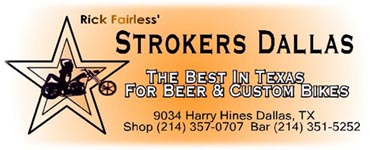

Just when you thought a project slipped off the lift, the paint arrived. Harold Pontarelli of H-D Performance, in Vacaville, California, made this puppy sing. It’s now mighty close to pavement miles. What started as a 1984 Mexican Police bike was transformed into a 1928 Shovelhead.

All the Compu-fire electrics possible were stashed on brackets built into the frame backbone, under the split halves, of the gas tanks. The finish on the frame, front end, brackets and wheel rims came from Custom Powder Coating in Dallas. The drive to finish the bike came from Lena, the lovely daughter of Rick Fairless, the owner of Strokers Dallas, formerly Easyriders of Dallas.

The magazine publisher determined that the 30-odd Easyriders stores around the country were not sending him enough bags of gold and pulled his name from their stores. Whatta shame, but Rick and many of the other store owners have bargained with supportive companies such as HOT BIKE and Big Dog. Some have chosen one of those names to stand behind, others, like Rick and Myron Larabbee, in Scottsdale, Arizona headed in their own directions. We’ll see what happens next.

This scooter is reminiscent of kits now being manufactured by Arlen Ness and Randy Simpson of Milwaukee Iron in Lynchburg, Virginia. Both of these talented builders are developing rolling chassis kits to house the driveline of your choice. Check with them if you have an engine and transmission around that’s dying for a nostalgic rejunivation.

This particular 1928 Shovelhead was built with scraps and components from as far away as England. Parts were ordered from sources that actually remanufacturer fenders, tanks and seats for old Harley restorations. Additional components were scavenged from a shop closing in Van Nuys, California, but the final creation, fabrication and assembly was handled by a couple of talented builders at Strokers in Dallas. JR started the project then escaped the country for four years, while Jim Stultz took over. Jim has since opened his own shop and JR returned to the fold for final assembly.

JR slicked the welds before anything was powdered or chromed and cut spacers for the rear 21-inch wheel. They ran into one problem with the battery box configuration. The battery wouldn’t fit. With some quick adjustments, a super strong Spyke gel battery slipped into place and kicked the scoot right off. The oil is housed in a portion of the gas tanks, so the box above the transmission handles only the battery and the ignition switch, with some wiring.

“When we build bikes,” JR said, “We completely mock them up before chrome and paint, but we don’t juice and start them. That creates too much of a mess to deal with before chrome and paint.” I rode through the final joining of parts with JR for tips that you could use. When the majority of the chrome and paint was in hand he began assembly. “First we had to send the wheels out to be relaced, trued and balanced,” JR explained. Since we went the extra mile to powdercoat the rims, the wheels had to be torn down, then re-assembled once the painted rims were returned. Note that the front 21 matches the 21 on the rear for that spindly, early look.

JR put the bike up with the front end, rear fender (it had tight clearances, so they mounted the fender before the wheel) rear wheel and front wheel, so it was a rolling chassis. Then the engine was installed (after the powder was shaved away from the mounting areas) and the transmission in that order. Before the driveline was tightened, he mounted the inner primary to insure proper alignment. Then the battery box was installed.

Next the electrical components were installed so that the wiring could be run between the gas tanks and hidden from view. Then the gas tanks/oil tank was installed on the backbone of the frame. Jim originally bent solid tubing oil lines, but they leaked some and tight bends were threatening oil flow. “I was concerned,” JR said, “Shovels and Pans need a lot of lubrication, quick. If I could, I’d pour the oil in through a big funnel. He was concerned about the myriad of hard bends and the small I.D. of the tubing. “I chose to use a larger diameter rubber tubing.”

Then JR mounted the brakes, which were both disc and mostly Performance Machine components. Final components followed including the primary drive, the handlebars, headlight and internal throttle to the S&S carb. Note the lack of controls on the bars.

“The engine fired off the first time,” JR said smiling. “We planned to Jet Hot coat the handmade exhaust pipes, but the boss, Rick Fairless, voted for chrome.” After the bike was fired and tested they yanked the pipes for dipping.

If you’ve read the previous installments, you caught the sixth wife threat looming over Bandit’s head. After five wives he has a deadly code, “No more wives”. So he drug his cowboy boots in a dire effort to stay out of Texas. He’s hoping his tactic worked, that the lovely Lena Fairless has grown and lost her desire to chain Bandit down one more time. She’s almost of age and being sought after by a line-up of young Dallas riders. Hopefully, one will sweep her off her dainty feet.

Bandit remains in California and awaits the arrival of the 1928 Shovelhead via a Truck from American Iron Horse, the custom bike manufacturer in Dallas. Then we’ll road test the scoot ourselves and take the photos needed for a full feature on Bikernet and in a bike magazine. Hopefully soon it will rumble down the old streets of San Pedro, its home.
–Wrench

2011 NCOM Convention
By Bandit |

If you’ve never attended an NCOM Convention it may be difficult to picture a conference room with nearly a thousand bikers (all wearing their club colors) who are listening attentively to a State Senator, a City Mayor or an AIM lawyer explain the subtle nuances of a bill, a law or the strategy for a repeal. You may not be able to picture members of clubs that may have had serious differences working together to solve problems that impact not only themselves but all motorcyclists. That’s exactly what happens at the annual NCOM Convention and you can rest assured that spirit of cooperation goes home with each attendee to their local MC Chapter, their Abate Chapter, Confederation of Clubs, or State Motorcycle Rights Organizations (SMRO).
The 26th Annual National Coalition of Motorcycle Riders (NCOM) Convention was held in Albuquerque May 5-8. Richard Lester, founder of NCOM and AIM (Attorney’s for Injured Motorcyclists) dedicated this years conference to Sputnik, the legendary legislative warrior who died in June 2010. Sputnik’s influence was recognized and his presence missed at every session of the conference from the Opening Ceremonies, the Ringing of the Bell in the General Session and a special remembrance during the Silver Spoke Award Banquet. Sputnik’s memory continues to inspire awareness and motivate warrior motorcyclists to continue to fight for our rights and freedoms as bikers.

I’m going to try to hit on what I found to be convention highlights in the various sessions I attended:
Legislative Task Force (LTF): South Dakota State Senator Jim Puttman is now the chairman of the LTF (a position held by Sputnik). The Legislative Task Force is a resource that your MRO is encouraged to use as a tool to support legislative research and even to help draft language that can be offered to your state or federal lawmakers. Reference the site: http://www.aimncom.com/ncom/ncom_board.htm for a list of the LTF members who serve as this resource. 
Opening Ceremonies: Attendance at the convention opening ceremony was truly impressive. Patches from all over the country, lawyers and politicians shared their experience and expertise to protect your rights and the lifestyle you chose when you decided to ride a motorcycle and wear an “MC” patch.
NCOM Chairman Doc Reichenbach provided an overview of the convention objectives, an list of “hot topics” concerning all motorcyclists and a welcome to attendees. The Mayor of Albuquerque, Richard Berry, welcomed us to his city and thanked us for coming back (NCOM was last in Albuquerque fifteen years ago) to enjoy the natural beauty of New Mexico, the attractions in Albuquerque and especially us for spending our money and enhance his economy. Doc closed the opening ceremony with a note of optimism when he said, “We learned the game and now we’re helping to write the rules!” He made this comment to emphasize the momentum that’s been built and the sophistication that we’ve achieved in winning the battles we continue to take on.
Jimmy first acknowledged Outsiders MC Double D for leading the Washington State COC’s effort to pass the country’s first profiling bill into law. The law forces local law enforcement agencies to adopt a written policy designed to condemn and prevent the profiling of motorcyclists, who have testified that police target them out of the mistaken assumption they belong to biker gangs. The language used in the bill was borrowed from a bill passed in 2002 that dealt with racial profiling and includes a training to address the problem.
Read more:
http://www.theolympian.com/2010/02/02/1124138/biker-profiling-bill-passes-first.html#ixzz1Ls1NxFGP
http://usdefenders.org/PDF/press%20release-Robert%20Christopher.pdf
Next was a story about a woman (a legally blind motor vehicle operator with no license) who killed a biker and was nearly released with a slap on the hands. Efforts of the Defender Program focused attention on the case and the woman was found guilty of manslaughter and was sentenced to twelve years in prison.
The Defenders made an unsuccessful attempt to kill the reauthorization of the Patriot Act. The Patriot Act, passed shorty after 9/11 was used to round up known terrorists, ship them to Guantanamo. That may have been a good use of the Patriot Act at the time but its presence on the books continues to provide law enforcement with the authority to arrest you and hold you without due process … it’s outlived its usefulness and is absolutely unconstitutional. We’ll continue to get another shot at the Patriot Act and we can expect other groups whose constitutional rights have been violated to join us in this fight.
All these issues are damn scary to me … how about to you? Yes, no, are you sleeping through this one? Do you think the Defenders Program has any value to you? Get with the program and support your ABATE, State Motorcycle Rights Organizations, COC and U.S. Defenders. How can you do this? Join the COC (most states are now including Independents) and identify your U.S. Defenders, make sure the Defender contact has your contact info and above all, respond to the Calls to Action that you support.

The Key Note address, by Rick Miera, who is a member of the New Mexico House of Representatives and the NCOM Legislative Task Force, a history of the National Highway Traffic Safety Administration (NHTSA) federal funding program from 1972 that threatened to withdraw funding for highway construction for states that did not pass a mandatory helmet law. New Mexico folded under this threat and passed a helmet bill in 1975 but repealed the law based on the unconstitutionality of the threat. Representative Miera predicts that we’ll continue to experience attempts (by both parties at both a State and National level) to continue trying to take away our freedoms.

Breakout Sessions: This session was for state specific reports from the various freedom fighters and MROs. I attended the session with three regions and fifteen states reporting that included: California, Colorado, Washington and Arizona.
The topics in this session ranged from the traditional to the ridiculous. A number of states, including California, continue attempts to modify their helmet laws. This seems to be a fight that continues infinitum and one that requires constant vigiliance.
Wyoming defeated a bill that would limit the speed a vehicle passing another vehicle could use, i.e., 10mph over the legal limit. Can you imagine passing an 18-wheeler while creeping along at only 10mph faster than the semi?
The breakout sessions gave me a good appreciation for the types of fights that various MROs face in their areas as they work to maintain the freedoms that you and I would like to continue enjoying.

You might be aware that Georgia has also accepted a $70,000 grant to fund motorcycle-only check points – setting up their checkpoints in early March just before Daytona Bike Week. Anybody that rode through Georgia along two major highways was stopped and often detained for as much at forty-five minutes.

Silver Spoke Award Banquet: The Convention ended on two relaxing and upbeat topics: a banquet on Saturday night and a Bike Blessing on Sunday morning. I made the banquet but saddled up and rode back to Arizona before the bike blessing – I like bike blessings, the potential of obtaining a bit more protection from hazards of he road is always attractive and I hated to miss this one. But missing Mother’s Day and the opportunity to take the little woman to dinner outweighed the potential for guaranteed safe passage home.
The banquet serves as a venue for the convention wrap-up speeches, which again remembered the late Sputnik’s dedication and achievements, and presentation of the Silver Spoke Awards. Bill Hayes, Boozefighter MC and author (Original Wild Ones – The Story of the Boozefighters MC) received a Special Recognition award for his latest book, American Biker, published in late 2010. Bill’s contributions to bike club literature and his efforts to swing the pendulum of perception about motorcycle clubs was recognized by NCOM. Other Silver Spoke Awards went to Allen West, Congressman from Florida for Government; Tim and Bonnie King, News Reporters from Oregon for Media; John Parham, J&P Cycles for Commerce; Jerry King, Cartoonist for Art; and Sharon “Lady Ninja” Cancel, Co-Director of the National Sport Bike Association for Special Recognition. The Ron Roloff Lifetime Achievement Award went to Harold “Gunny” Hutcheson, the AIM Chief of Staff from Oregon.

–Gypsy Raoul
1928 Shovelhead Runs Part VII
By Bandit |

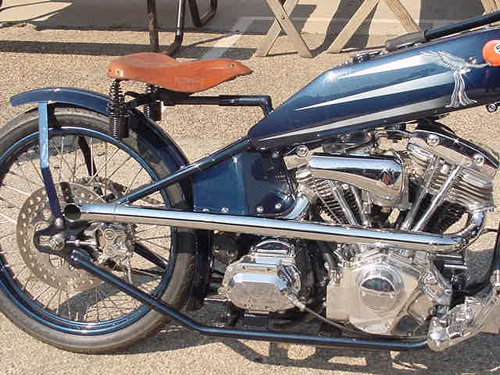
Here’s the deal. The 1928 project was recently completed except for a stylish exhaust system. The antique notion was based on racers from the ’20s, something way off the pavement, open and short.
JR, the service director of Strokers, explained the steps, “They were cut and pasted together. Bits and pieces from the scrap yard, combined with pre-bent 1 3/4-inch diameter 16-gauge tubing, which is similar to stock. We also used stock exhaust manifold chunks off scrapped systems.”
He hung up, and I sat back in my chair perplexed. I was faced with the same daunting task when we built the Amazing Shrunken FXR pipes. I had a myriad of questions and called back.
“Hold on JR,” I said trying to capture his attention while he was carb tuning a running, 100-inch, RevTech motor.
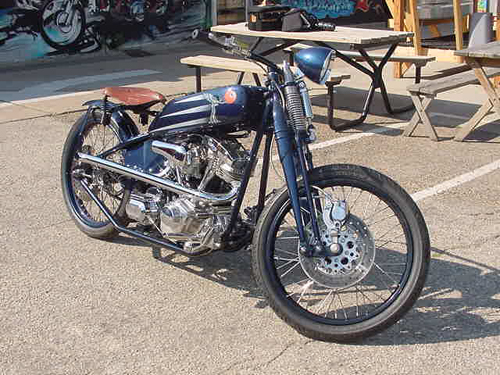
“What the hell do you want?” he said in a Texas gunslinger drawl.
“Do the pipes have baffles? I asked holding the phone like you grasp a girl you don’t want to lose.
“Nope,” JR said.
“Are there any brackets other than the exhaust manifolds?” I rattled the question rapid-fire quick, hoping that he wouldn’t hang up.
“One,” he said, “anything else?”
“Yep,” I barked.
“I gotta go,” JR fumbled and the straight-pipe, 100-incher roared.
“Wait,” I begged.
He hung up. I looked at the phone as if someone sliced the wires leading to the pole, and the died. The next day I called back. JR was off on Tuesday. I called Wednesday and the receptionist fed me to the service department. The service writer was courteous, told me JR was in but couldn’t find him.
I called the next day. He was on the premises but unavailable. I called the following day, still no JR. I was growing a complex. I called everyday for a week, no luck. I went around him to his boss, the magnificent Rick Fairless, the mastermind behind Strokers of Dallas with Strokers Ice House, one of the most happening biker bars in the South. An e-mail sprang back. JR suffered a heat stroke after road testing a new Big Dog, for two hours in 102 degrees, then helping his daughter move to college. I felt like shit.
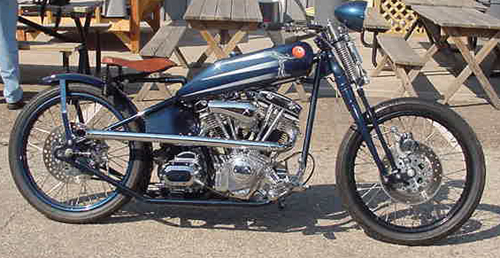
Apparently heat strokes are notorious and can become an annual nightmare. This was his third devastating attack. We finally hooked up again, and he coughed up his exhaust pipe making secrets. Strokers is noted for their customs, which rock from old school radical choppers to hand-fabricated marvels. JR is learning more and more fabrication techniques to expand the shop’s capabilities.
“We’ve been performing sheet metal functions, with hammers, successfully,” JR said, “but with an English wheel and Yoder hammer machine, we can speed up the process. I’m taking classes.”
They don’t manufacture many exhaust systems, and when they do it’s by hand.
“You can buy exhaust pipe segments, 1 3/4-inch to 2 1/2 inches in diameter, from hot rod shops, and piece any pipe together,” JR explained. “We buy “U”, “S” shaped bends and straight chunks.”
Since I also faced the delicate job of trying to hold two chunks perfectly in line and tacking them, I asked JR how he handled the task.

“We discovered magnet clamps for holding chunks of pipe,” JR said, “they’re available from Harbor Freight Tool Supply. I made flat clamp brackets in dissimilar lengths from 3 to 6 inches long with a variety of holes drilled in them in an arch. There are two “C” clamps attached, on at either end. I welded bolts to the clamps so I can move them from hole to hole, on the bracket, or change the angle.
I asked a final nervous question about the allowable gaps when tacking pipes.
“I try to make the fit as close and precise as possible,” Jr explained. We continue to grind the edge of the pipe with a 90-degree, die grinder and a 2-inch 3M sanding disc. We also have a band saw with a tilt-able head for slicing exhaust at just the right angle.”
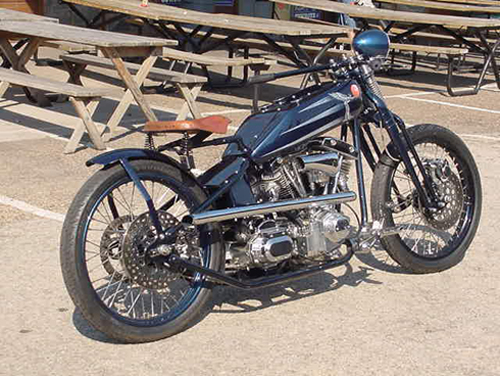
“The pipes haven’t blued,” I said looking at the shots.
“Yeah,” JR said. “We use three coats of Blue Shield by Kreeme, the guys who make the tank sealant.”
“So how loud are these puppies?” I asked holding my breath. They looked like window breakers.
“Not bad,” He muttered looking at the shop clock. I was burnin’ daylight in Dallas. “They’re loud enough that ya know what ya got.”
“That’s it,” I said. “I won’t darken your phone again.”
“It’s happy hour at Strokers,” JR barked, and I could sense that I was losing him.
“It’s party time,” were his final words.

1928 Shovelhead Comes To California Part VIII
By Bandit |

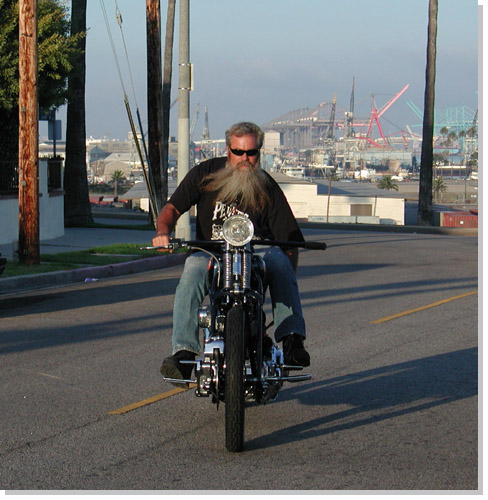
Master builder and mechanic, Deacon, from Pro-Street in Oahu.
Bob Kay. from American Iron Horse. was a bro and shipped the retro Shovelhead. from Strokers in Dallas. to LifeStyle Cycles in Orange County, California along with a new batch of Dallas Choppers. It arrived the day before a handful of weary travelers stumbled into Los Angeles. on their way home, from Sturgis, Glen and Kerry Priddle were headed back to Australia after spending almost a month, with a dozen Aussies, roaming the mid west.
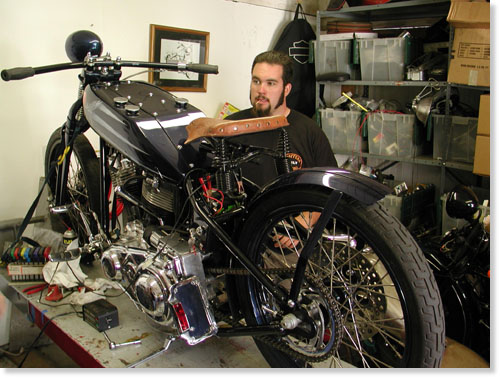
Deacon’s son Chase and the 1928 Shovelhead.
Deacon, his son Chase, and the son’s girl Amanda rode several thousand miles averaging 95 mph wherever they rode. Deacon and Chase are both master mechanics. The ol’ man’s shop, Pro-Street, is located on Oahu, (808) 236-0405 and he’s negotiating with Billy Lane of Choppers Inc. to build engines for Billy’s Discovery Channel Bikes. His son is working in Oregon, but as soon as he returns, he’s packin’ his shit and heading back to the islands.
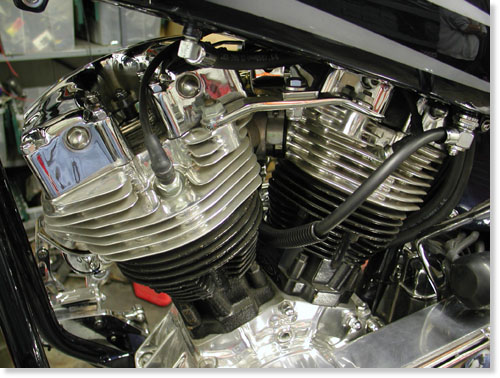
JIMS machine rebuilt and detailed the engine. It was sharp and runs like a top.
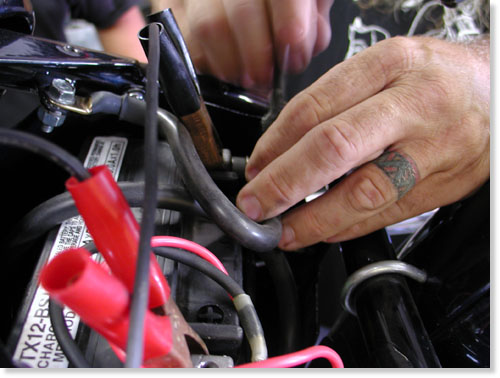
Charging and checking battery connections.
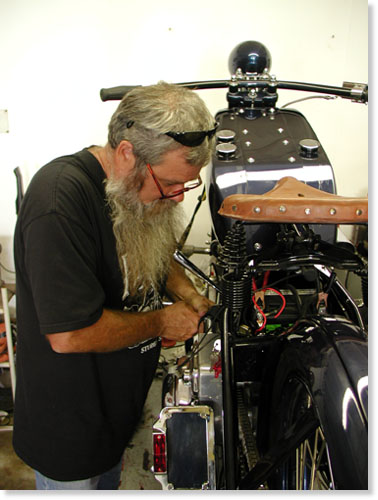
Deacon checking the solenoid.
Deacon rolled into the Bikernet Headquarters just as the Shovel arrived and we attempted to fire the beast to life. I moved the seat forward, detailed the front end and charged the battery. But, even with a fresh battery, she wouldn’t engage. Deacon suspected the aftermarket solenoid. Seems the spacers and gaskets are too thick, just enough to prevent the solenoid from grabbing the shaft. I trimmed the gasket with an Exacto blade and Deacon ground the face of the spacer. Installed, it worked like a champ. We took it for a ride.
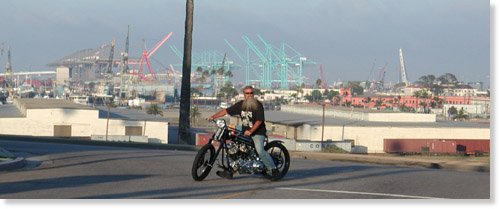
Los Angeles Harbor and our first roadtest.
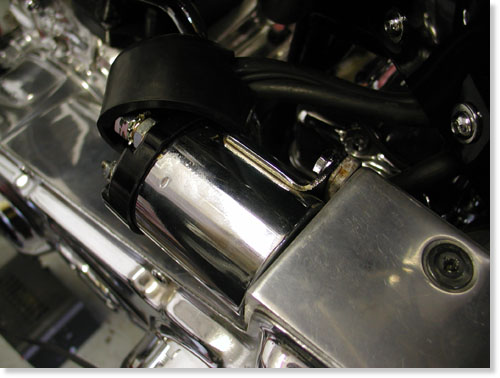
First Deacon checked the connections and voltage at the solenoid. He also shorted across the leads with an Allen wrench to see if the circuit was operating properly.
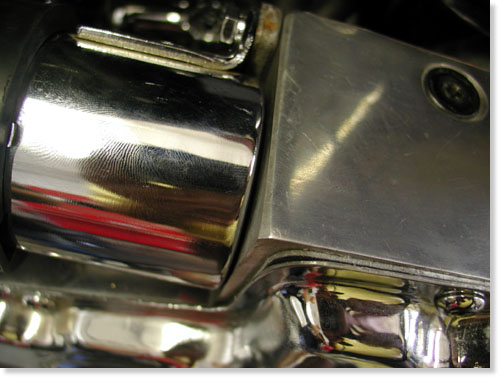
The solenoid replaced after the gasket around the base was trimmed and the spacer, behind the unit, shaved. Worked perfectly.
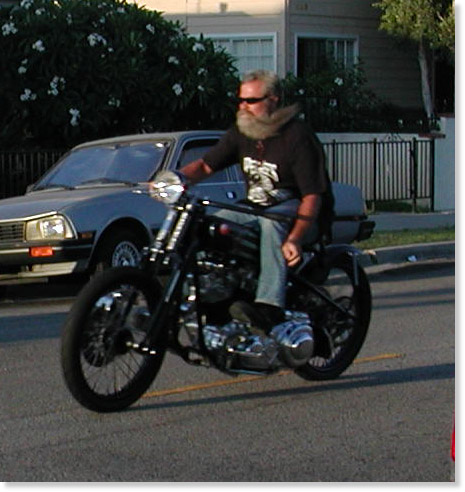
Checkin’ the gears.
It was impossible to jam the suicide shifter into nuetral once the bike was running, even while rolling. Deacon and chase adjusted the clutch, and recommended a Rivera, old school, clutch pack to eliminate chatter and afford the rider smoother shifts. The clutch wobbled and was too tight to find neutral. They loosened the springs until only a thread showed past the adjustment nuts and the spring retainer ran true.
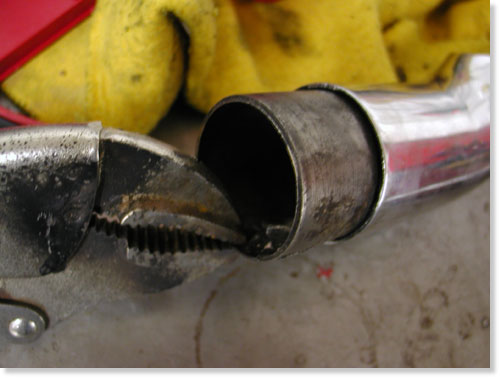
Can you see the cracks?
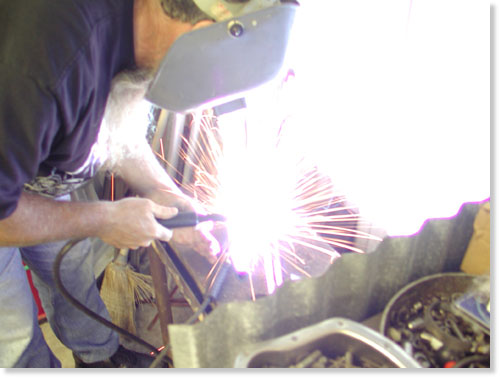
The Millermatic 175 hard at work.
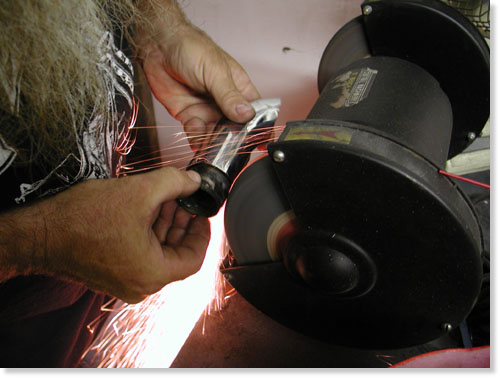
Deacon built a bead then ground it smooth as a baby’s ass.
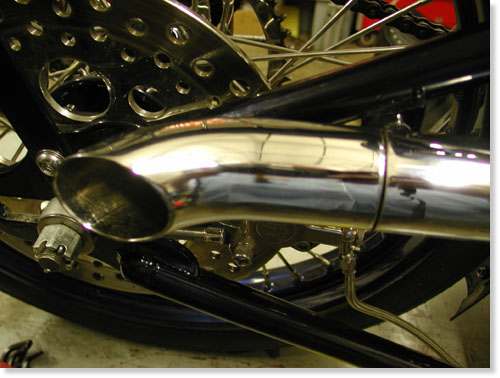
The tip installed, solid as a rock.
I developed padded fork stops and while running we noticed that the clean, handmade, Stroker’s pipe tip was rattling with only one bolt holding it. Upon removal we discovered that the area around the installation nut had already cracked and Deacon grabbed the Millermatic. He welded the cracks and nut for more strength. Then we discovered that the tip shelf was too small, so the pipe end had a tendency to vibrate. Deacon went back to the welder and built a bead around the outside, of the shelf, then ground it to fit. A much cleaner/tighter fit, and the pipe didn’t require an additional fastener.
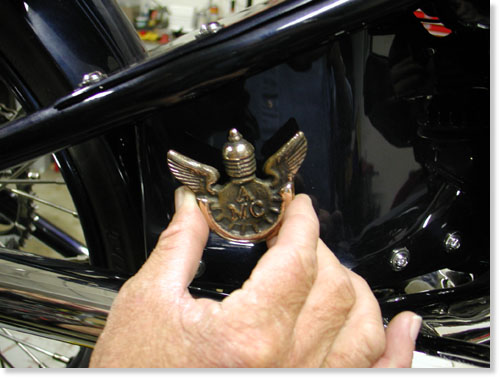
Anybody know how old this cast bronze emblem is?
While in Hawaii at the first Choppers Only Show in Wakiki, I gave Deacon, the promoter, a handmade belt buckle for being a gracious host. He returned the favor with an old license plate doodad from the Antique Motorcycle Club. It was destined for the Shovelhead.
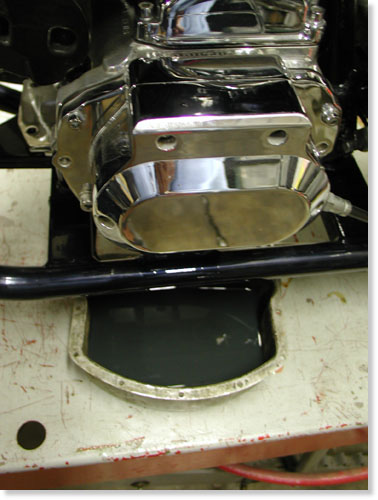
While testing the shifting, clutch and tranny, the gears seemed to bang harshly. We checked the oil level, which seemed precariously low. It wasn’t bad, but we drained the oil and replaced it with fresh Custom Chrome tranny lube.
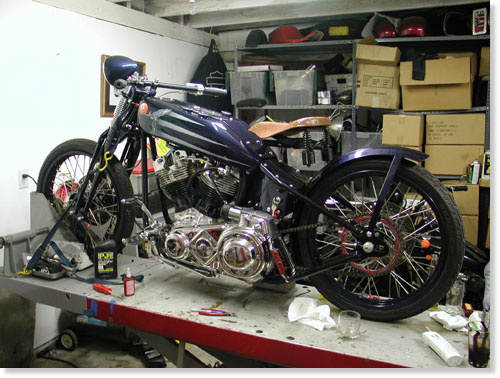
The 1928 Shovel was ready to rock and so were we. Deacon and Glen broke out harmonicas and kicked off the blues. They sampled the Irish whiskey, Tullamore Dew, Sin Wu barbecued and the party rolled on.
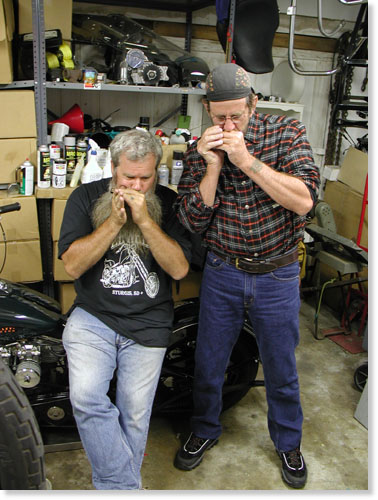
Deacon and Glen bringing down the Bikernet Garage.
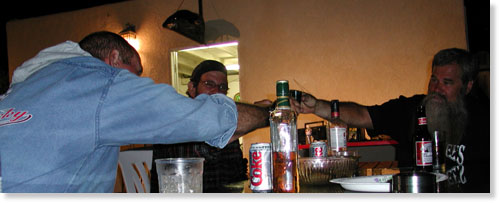
One mo’ shot of Tullamore Dew.
Helluva night, sharp bike and times to always remember. The next day Deacon air-freighted his 2003 FLH to Oahu and grabbed a flight. His son and Amanda boarded their basket case Softail and rode north. Glen and Kerry hid out in Los Angeles and waited for their flight back to Australia, and we dusted off the headquarters and pretended to go back to work.
Stay tuned for the next adventure of the 1928 Shovelhead.
–Bandit
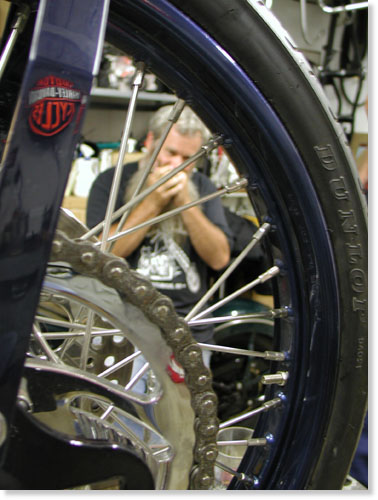

The FXR Master Speaks
By Bandit |
This is a good one for several reasons: First, it’s an FXR; second, the owner/rebuilder is a friend; third, he’s a master martial arts trainer and no one to fuck with, even if he is old, and last but far from least, is his bike building mantra. He builds bikes like no one I have ever known. But let’s back up and start from the beginning.
This is the year of the FXR for Bikernet 2011. We are building two, with Spitfire single-loop frames and girder front ends. I’m building one for my son and we are both riding to Sturgis. A lot of us are still big FXR and Evo fans, so we’re working the FXR mantra about the best H-D chassis ever built. This bike is a sharp example of the popular ’80s configuration, with an Arlen Ness faring up front. It’s even got one of those goddamn air dams at the bottom of the lower legs.
“It’s the best bike I’ve ever owned, aside from the FXR you and I built, for hot rodding around town,” Steve said.
That’s right. I currently have a 1946 Indian in my office that I traded my FXR custom to Steve for about 1997. Steve implanted his custom detail skills on it, and that puppy was beautiful. He sold it to his son and made him promise never to unload it, so you know exactly what he did. Steve’s been chasing that bike ever since.
I met Steve in the mid ’90s before he was a Dave (motorcycle gang in Washington), with Russ Tom, one of the owners of Downtown Harley in Seattle, who passed in a plane accident. Russ was a helluva bike builder. We met when I featured several of his bikes through a contact with Terry Lovering, another martial arts master, but for several years, Steve came down for Love Rides and other functions and we hung out. I trained in close quarters combat with Mark Lonsdale, and Steve is an 11-time World Sports Karate Champion, who fought and won in the Goodwill Games, and has won 160 national championship fights. He’s what you might call the master.
He gave me training tips from time to time, since he has run the same dojo in Tacoma for 25 years in the same location. Since 1977, he has trained kids, offered them crucial discipline, focus, and respect. He started teaching martial arts in the basement of his home. I’d much rather train with his lovely wife, Suzanne. If you work out with Steve, you get your ass kicked at every class. I’m too old for that.
Let’s see, how are we doing with the list? Ah, the last one. His bike-building mantra. Steve attacks a bike build like he would refine a martial arts student. He gets a bike he likes and refines every aspect of the machine without messing with the original design or structure, and paint. He did the same thing with my FXR, built primarily at High Tech Custom Motorcycles in Van Nuys. That shop is long gone.
The bike was a very sharp FXR and we featured it in VQ magazine. So what did Steve do to it? He pumped up the performance, took every chrome component off, and had them all rechromed at the same custom shop. He touched up the paint and cleared it some more. Anything that was powder-coated he stripped and powdered again. In short, he detailed and refined every aspect, and if any element was not of the finest caliber, he shit-canned it and replaced it with the best.
You would not have believed the difference once Steve was finished. He took a bitchin’ custom bike and made a Rolex out of it.
He poured the same philosophy all over this bike. It’s basically the same bike Junior Nelson built several years ago. Junior is a big-time Washington state pin striper who’s mostly into cars, but he built this FXR and it collected dust in the back of his shop.
When Steve got ahold of it, he pulled the motor, enhanced the performance package, flowed the heads, and detailed the exterior. He left the original paint alone, but added the old Arlen Ness fairing and the Ness spoiler, a handful of new pinstriping and the Irish Notre Dame character on the air dam.
“I liked the louvers on the fairing that match the Ness side covers,” Steve said.

He rechromed everything, swapped the forward controls for modified stock mid controls, re-powdered everything, added a speedo landing to the bars, and mounted a tool kit to the swingarm so he couldn’t lose it. He also added a Ness oil gauge, and Ness turn signals.
At 65, he tries to spend more time with his three sons and his daughter, drag race in the sand dunes, and hopes to ride to Sturgis with the Hamsters in the near future. We may need to start an FXR club for all us diehard FXR fans.
1993 FXRC Street cafe/salt flatter Extreme Tech Chart
Background info.
owner: Steve “Mad Dawg” Curran
Bike’s name: Irish Reaper
Brand name: Harley-Davidson
Model: FXRC
Year: 1993
Assembly: Steve Curran and Dan Eberhartd in Dan Eberhartd’s garage
Paint/graphics: JR. Nelson pin stripping, paint and graphis. Black with pearl green metal flake. House of Color. Gold leaf.
Power coating: J&D Power Coating

Motor Specs
Year: 1993
Manufacture: Harley-Davidson
Model: EVO
Displacement: 80 CU. IN.
Lower end/balancing: H-D
Cases/Cylinder heads: H-D / Screaming Eagle Pro
Piston/Cylinders: H-D / Screaming Eagle Pro high-compression forged piston kit
Carb: CV H-D
Air cleaner: H-D P&N
Exhaust: Bub
Cam/Rocker arm: H-D Screaming Eagle SE-11
Push Rods: H-D Screaming Eagle Perfect fit
Clutch: AIM
Horse power: 95.05 Back wheel 99.02

Transmission:
Year: 1993
Manufacturer: H-D
Model: FXRC
Suspension type: Coni-Holland
Style: Softtail

Forks
Year: 1993
Manufacture: H-D
Style/type: H-D narrow gluide

Wheels and brakes
Front wheel: 19
Brake caliper: H-D Rotor: Super spoke
Rear wheel: 16
Brake caliper: H-D Rotor: Super spoke

Accessories
Risers: Ness/ Curran, Eberhartd
Grips/foot pegs: PM
Hand Controls: H-D
Taillights: Cats eye
License plate mount: Ness
Mirrors: Downtown
Seat: Le Pera
Gas Tank: FXR H-D
Fenders: Front, H-D extended Rear, Ness
Gauges: Mini speedo
Foot contols: H-D
Fairing kit & side covers: Ness

A little background:
Prof. Steve Curran, Ph.D
Tacoma, Washington
11 times world sport karate champion
Goodwill games gold medalist
Winner of over 160 national and international championships
Started martial arts in Hawaii in Jan 1967
10th degree black belt
Vietnam vet
Wife: Suzanne, 7th degree black belt
Children: Brian, Craig and Kim. All 7th degree black belts
Six grandchildren,
Film and TV stuntman/actor
Worked with Chuck Norris on Walker, Texas Ranger and Chuck’s last movie, The Cutter.
Riding hard since 1965 (hard core)
First Sturgis was 1976 100th Ann. of the U.S.
Has taught martial arts in Tacoma since 1977 (school)
Contact info:
Kaicho
Steve Curran Karate
3814 N 27th St.
Tacoma, WA 98407
253-759-4262
SteveCurranKarate@comcast.net
Fairing for the V-Rod
By Bandit |
When I first got the V-Rod, I swore that I would never change a thing on her. As most promises go, things change the more educated you get with the experiences life gives you. Last year I rode to Sturgis and tied a sleeping bag to my handlebars…almost making a rudimentary wind-block. While it looked hideous, it definitely blocked the wind and made the more than 3500 mile trip bearable. Over the last year I have tried to find a decent windshield, but just couldn’t get over the looks, as they either looked goofy or were just too hideous for me to attach it to my bike. While a windshield is a great idea….I want to make sure my bike still looks good, well at least to me.
Then while scouring 1130cc.com, I saw a bike by a guy named Shea who had a Trask powered nasty bike dripping with attitude. I liked the concept behind his bike but once I saw the pics of his bike in a magazine, decided I wanted to change the height of the fairing as I could tell his didn’t really block much wind. Although I have fallen for the style over function bug before, I am also adamant about not adding anything to my bike that will make it less comfortable or harder to ride as that is a mistake I vowed not to repeat.
The Fairing came form a distributor on E-bay and it included the fairing, brackets, mounting hardware, and shorty plexiglass windshield. I decided to put the pieces together and place it on the bike just to see how it looked. Once I had it on, I decided t rig it up with zip ties and finagling the brackets between my turn signal mounts to try it out. Initially I was VERY pleased, but knew I’d have to fabricate something to make the mounting more permanent and stable….I called in help from a few friends.
We stared with the stock pieces and took just a few hours to fab what we needed. The only additional hardware I bought was 4 pipe supports from Lowe’s, 4 plastic spacers, and 4 3/8 bolts to attach the fairing mounts to the pipe supports. We mounted the pipe supports to the fork tubes, then attached the newly modded fairing mounts to the pipe supports. The system worked perfectly.
I recently made a run with some friends and have ridden about 500 miles with the new system. The air is blocked from the bottom of my neck down to my waist, keeping me free of fighting the wind while riding. I can take both hands off of the handlebars while riding 90 mph and still take a few pics. The bike tracks straight and I think the design actually pushed my front end down making it even more stable than before. Overall, I’d say this is a great improvement and expect to see more V-Rods with similar set-ups very soon. I really wouldn’t be surprised to see the Motor Company do something like this 2 years from now…since they are always behind what works on the street. Until next time…
Floorboard Peg Review from The Tail Gunner
By Bandit |
This month we’ll take a look at the Jack Knife folding floor board pegs from FBI. At first glance, I thought what a great idea, low and hidden right where need them, mounted under the floor board. The pegs swing out when needed, and back in when not in use. So I ordered them.
Delivery was quick and following their instructions, I had them on in no time. Now for the test ride! First thing I learned, you have to stop and swing them out by hand, since there is no way to catch them with your foot while riding.
So now they are swung out, ooooops, second problem arises. Since they are directly mounted to the floor board, they give a little, causing the peg to bend downwards and your foot slips off. This was unacceptable, but I liked them, so I thought there must be a way to fix this. My solution, was to add a screw stop (see picture) that would limit the full swing outward, sort of creating an angle to keep my foot on the peg.
I drilled and tapped a 3/16-inch hole for the stop set screw (see picture).My modification worked and did what I intended it to, but alas, the floor board still bends enough that no matter what you do, it just doesn’t stop the downward bend. I did a little research and found the company that actually makes the Jack Knife Peg (IMT) Innovative Metal Technology’s also makes a brace that supposedly stops the bending motion. I looked on IMT’s web site and did not find any braces. However, IMT has an installation video and installation guide for your viewing pleasure.
The other problems I encountered, where the trimming of the floor board grommets, this sort of screws up
your floor boards ability to secure it, however it works as long as you’re patient and willing to trim your stock parts.
The other problem that arose, was one of the pegs was scraping the bottom lip of the floor board (see picture),
so I had to trim the bottom portion of the chrome lip for clearance.
All in all, I give the project a two, on my scale of five. The installation wasn’t bad, but the fit and functionality wasn’t what was expected. IMT is at www.imtnebraska.com.
The price for the Jack Knife Pegs at FBI or IMT is the same, $179.95. Kuryakyn makes a similar product called Flip Blades, hope it works better than this product did. Ride On! Fat Bob out, till next month.

RIDIN’ THE WIND WITH LORENZO LAMAS
By Bandit |

Editor’s Note: I’ve known Lorenzo Lamas since we featured his Knucklehead Chopper in Easyriders way back when, then he threatened to make one of my books into a movie. Recently Chad Greulach and Lorenzo reached out to Bikernet and we discussed a series of articles written by Lorenzo. Ya see, he’s not just a celebrity. Actually, as you will see, he’s always been a biker, even when it pissed off his movie star dad. But you’ll read it all here as we cover the life and times of Lorenzo Lamas.–Bandit
As a pre-teen kid, I was a Hot Wheels fanatic. Those ’60s Muscle Cars were my thing and my buddies and I would race our toy Chargers against our Chevelles for hours and hours on end. Then in spring of 1969, what started as a love of Hot Wheels turned into a true passion that’s lasted all these years.
Billy Hildreth, Jay Johnston and I were all 11 years old and we ran as our own pack of prepubescent renegades in the Santa Monica Mountains, just west of Los Angeles. Each of us had our own rigid frame minibike with a Briggs & Stratton lawn-mower powerplant and just enough juice to get the wind blowing in our faces. Back then, at least in our neighborhood, our scoots were considered pretty state-of-the-art and we rode them hard.
But everything changed in 4th Grade.
The first true object of my affection was the new Honda CT-70. For anyone my age at the time, this was the only bike to have. I got my hands on a brochure that I took to school with me and studied all day, every day, for weeks on end.

A 5th grader named Patrick was the first to get his for Christmas. His was gold. Somehow Patrick always got the cool stuff first and he kicked off a neighborhood challenge to prove who’d be cool enough to get theirs next.
There was no way I’d be able save enough cash making $10 a weekend mowing lawns and washing cars. For the next year, I was my mother’s shadow. If I knew she was cooking, the brochure was next to the kitchen sink. If she was heading to the garage, the brochure was on her front seat. I absolutely wore her out. I had no choice.
Billy was the next of our pack to score. His was blue.
My mother had been dating a television producer named Skip and somehow Skip had gotten the message. Just as it seemed all pre-pubescent hope was lost, Skip’s white Mercedes 4-door sedan rolled to a stop in front of the house. In its trunk, it held cargo that would change my life forever. In the back of that Mercedes was a brand new Honda CT-70 Mini-Trail. Mine was red. Even cooler than the brochure.

At that point in my life, there had been no bigger moment. It didn’t take long though, after pulling my new machine from Skip’s trunk, for us to run into our first snag. No battery. No problem.
Proud as an 11-year old kid could be, I rolled my shiny steed into my bedroom and shut the door. I tightened the knobs on the collapsible handlebars and I stared at the bike for an hour. I read every part of the engine case and I even took time to absorb whatever was written on the chainguard (though I didn’t read Japanese). I inhaled the sight of my bike for a full hour.
I couldn’t help myself. I pushed my new ride up the street to Billy’s house and, when he answered the door, he shared in my excitement. We both felt the rush of adventure our first real bikes represented.
In the two weeks it took for Skip to track down a backordered Yuasa battery for my bike, I got to know it damn well, rolling it uphill and coasting downhill. When the battery did arrive, there was no stopping me, Billy and Jay.
We experienced our wonder years together on those bikes, spinning adventures, dreaming of endless rides together and outrunning more than a few park rangers on the fire trails of the Santa Monica Mountains.

Lorenzo Lamas built his first chopper in 1979, long before his starring role on the international hit television series, Renegade. He’s been a passionate rider and motorcycle enthusiast for more than 30 years.
In 2007, Lorenzo and television producer, Chad Greulach, met on a set in Nashville and shared their love of the ride back home in Los Angeles. By August of 2009, Lorenzo and Chad had recruited world-class builder, Eddie Trotta and set out to deliver a singular riding experience and sense of expression that would exceed all others in the industry.
By November 2010, Lorenzo Cycles had enlisted Ralph Randolph as its 2nd master builder and within its first 2 years, Lorenzo Cycles had established strategic relationships across multiple categories and expanded its brand into Europe, Latin America, India & Asia.





